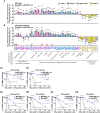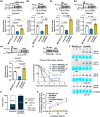The RNA degradation enzyme RNase E is essential for early flagellar assembly in Escherichia coli
- PMID: 40894857
- PMCID: PMC12399333
- DOI: 10.1093/pnasnexus/pgaf269
The RNA degradation enzyme RNase E is essential for early flagellar assembly in Escherichia coli
Abstract
Escherichia coli endoribonuclease E (RNase E), encoded by the essential rne gene and conserved across γ-Proteobacteria, plays a central role in RNA processing and decay. We show here that rne-null strain, rne-null strain complemented with catalytic-null RNase E mutant, and C-terminal-truncated strain (Rned500) all lack flagellar biogenesis and motility under both aerobic and anaerobic conditions, which are restored by wild-type RNase E complementation. The Rned500 displays dysregulated expression of the three-tiered flagellar transcriptional cascade, increased stability of flagellar mRNAs, and reduced flagellar protein levels through sRNA-dependent translational inhibition. However, ectopic expression of flagellar master regulators or flagellar proteins fails to restore flagellar biogenesis and motility. To investigate the underlying defect, we examined the cellular localization of the early flagellar structural protein FliF and found it mislocalized in Rned500, indicating a disruption of early flagellar assembly. This defect is further supported by the impaired secretion of the flagellar anti-sigma factor FlgM in Rned500, a process that requires a functional flagellar basal body. Complementation with wild-type RNase E in Rned500 fully restores expression of the flagellar cascade, proper membrane localization of FliF, flagella formation, and motility. Wild-type RNase E-expressing strains, but not Rned500, activate Toll-like receptor 5 (TLR5)-dependent nuclear factor-kappa B signaling in THP-1 human monocytic cells through flagellin. This response, confirmed by a TLR5 dual-luciferase reporter assay in transfected HEK293T human embryonic kidney cells, highlights RNase E's role in enabling flagellar expression required for cellular immune activation. Collectively, these results identify RNase E as a key flagellar biogenesis regulator, revealing novel posttranscriptional control mechanisms.
Keywords: RNase E; TLR5-NF-κB signaling; flagella; posttranscriptional regulation; sRNAs.
© The Author(s) 2025. Published by Oxford University Press on behalf of National Academy of Sciences.
Figures






Similar articles
-
PrtA-mediated flagellar turnover is essential for robust biofilm development in Serratia marcescens.Appl Environ Microbiol. 2025 Aug 21:e0126125. doi: 10.1128/aem.01261-25. Online ahead of print. Appl Environ Microbiol. 2025. PMID: 40838731
-
Prescription of Controlled Substances: Benefits and Risks.2025 Jul 6. In: StatPearls [Internet]. Treasure Island (FL): StatPearls Publishing; 2025 Jan–. 2025 Jul 6. In: StatPearls [Internet]. Treasure Island (FL): StatPearls Publishing; 2025 Jan–. PMID: 30726003 Free Books & Documents.
-
Characterization of Flagellum and Toxin Phase Variation in Clostridioides difficile Ribotype 012 Isolates.J Bacteriol. 2018 Jun 25;200(14):e00056-18. doi: 10.1128/JB.00056-18. Print 2018 Jul 15. J Bacteriol. 2018. PMID: 29735765 Free PMC article.
-
Home treatment for mental health problems: a systematic review.Health Technol Assess. 2001;5(15):1-139. doi: 10.3310/hta5150. Health Technol Assess. 2001. PMID: 11532236
-
Antidepressants for pain management in adults with chronic pain: a network meta-analysis.Health Technol Assess. 2024 Oct;28(62):1-155. doi: 10.3310/MKRT2948. Health Technol Assess. 2024. PMID: 39367772 Free PMC article.
References
-
- Apirion D, Lassar AB. 1978. A conditional lethal mutant of Escherichia coli which affects the processing of ribosomal RNA. J Biol Chem. 253:1738–1742. - PubMed
-
- Mackie GA. 1992. Secondary structure of the mRNA for ribosomal protein S20. Implications for cleavage by ribonuclease E. J Biol Chem. 267:1054–1061. - PubMed
-
- Lin-Chao S, Wong TT, McDowall KJ, Cohen SN. 1994. Effects of nucleotide sequence on the specificity of rne-dependent and RNase E-mediated cleavages of RNA I encoded by the pBR322 plasmid. J Biol Chem. 269:10797–10803. - PubMed
-
- Ono M, Kuwano M. 1979. A conditional lethal mutation in an Escherichia coli strain with a longer chemical lifetime of messenger RNA. J Mol Biol. 129:343–357. - PubMed
-
- Lin-Chao S, Cohen SN. 1991. The rate of processing and degradation of antisense RNAI regulates the replication of ColE1-type plasmids in vivo. Cell. 65:1233–1242. - PubMed
LinkOut - more resources
Full Text Sources

